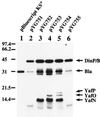Multiple pathways for SOS-induced mutagenesis in Escherichia coli: an overexpression of dinB/dinP results in strongly enhancing mutagenesis in the absence of any exogenous treatment to damage DNA
- PMID: 9391106
- PMCID: PMC28386
- DOI: 10.1073/pnas.94.25.13792
Multiple pathways for SOS-induced mutagenesis in Escherichia coli: an overexpression of dinB/dinP results in strongly enhancing mutagenesis in the absence of any exogenous treatment to damage DNA
Abstract
dinP is an Escherichia coli gene recently identified at 5.5 min of the genetic map, whose product shows a similarity in amino acid sequence to the E. coli UmuC protein involved in DNA damage-induced mutagenesis. In this paper we show that the gene is identical to dinB, an SOS gene previously localized near the lac locus at 8 min, the function of which was shown to be required for mutagenesis of nonirradiated lambda phage infecting UV-preirradiated bacterial cells (termed lambdaUTM for lambda untargeted mutagenesis). A newly constructed dinP null mutant exhibited the same defect for lambdaUTM as observed previously with a dinB::Mu mutant, and the defect was complemented by plasmids carrying dinP as the only intact bacterial gene. Furthermore, merely increasing the dinP gene expression, without UV irradiation or any other DNA-damaging treatment, resulted in a strong enhancement of mutagenesis in F'lac plasmids; at most, 800-fold increase in the G6-to-G5 change. The enhanced mutagenesis did not depend on recA, uvrA, or umuDC. Thus, our results establish that E. coli has at least two distinct pathways for SOS-induced mutagenesis: one dependent on umuDC and the other on dinB/P.
Figures


Similar articles
-
Induction of only one SOS operon, umuDC, is required for SOS mutagenesis in Escherichia coli.Mol Gen Genet. 1993 May;239(1-2):137-44. doi: 10.1007/BF00281612. Mol Gen Genet. 1993. PMID: 8510643
-
The genetic requirements for UmuDC-mediated cold sensitivity are distinct from those for SOS mutagenesis.J Bacteriol. 1996 Aug;178(15):4400-11. doi: 10.1128/jb.178.15.4400-4411.1996. J Bacteriol. 1996. PMID: 8755866 Free PMC article.
-
Alleviation of EcoK DNA restriction in Escherichia coli and involvement of umuDC activity.Mol Gen Genet. 1992 Jan;231(2):265-75. doi: 10.1007/BF00279800. Mol Gen Genet. 1992. PMID: 1310522
-
[The SOS system: mutagenic response to DNA damage].Postepy Biochem. 1992;38(2):59-64. Postepy Biochem. 1992. PMID: 1461841 Review. Polish. No abstract available.
-
Mutagenesis and more: umuDC and the Escherichia coli SOS response.Genetics. 1998 Apr;148(4):1599-610. doi: 10.1093/genetics/148.4.1599. Genetics. 1998. PMID: 9560379 Free PMC article. Review.
Cited by
-
Evidence for roles of the Escherichia coli Hda protein beyond regulatory inactivation of DnaA.Mol Microbiol. 2012 Aug;85(4):648-68. doi: 10.1111/j.1365-2958.2012.08129.x. Epub 2012 Jul 13. Mol Microbiol. 2012. PMID: 22716942 Free PMC article.
-
Transcriptional profiling of colicin-induced cell death of Escherichia coli MG1655 identifies potential mechanisms by which bacteriocins promote bacterial diversity.J Bacteriol. 2004 Feb;186(3):866-9. doi: 10.1128/JB.186.3.866-869.2004. J Bacteriol. 2004. PMID: 14729715 Free PMC article.
-
Inhibition of mutation and combating the evolution of antibiotic resistance.PLoS Biol. 2005 Jun;3(6):e176. doi: 10.1371/journal.pbio.0030176. Epub 2005 May 10. PLoS Biol. 2005. PMID: 15869329 Free PMC article.
-
Error-free and error-prone lesion bypass by human DNA polymerase kappa in vitro.Nucleic Acids Res. 2000 Nov 1;28(21):4138-46. doi: 10.1093/nar/28.21.4138. Nucleic Acids Res. 2000. PMID: 11058110 Free PMC article.
-
Highly mutagenic replication by DNA polymerase V (UmuC) provides a mechanistic basis for SOS untargeted mutagenesis.Proc Natl Acad Sci U S A. 2000 Jan 18;97(2):565-70. doi: 10.1073/pnas.97.2.565. Proc Natl Acad Sci U S A. 2000. PMID: 10639119 Free PMC article.
References
-
- Friedberg E C, Walker G C, Siede W. DNA Repair and Mutagenesis. Washington, DC: Am. Soc. Microbiol. Press; 1995.
-
- Echols H, Goodman M F. Annu Rev Biochem. 1991;60:477–511. - PubMed
-
- Witkin E M, Wermundsen I E. Cold Spring Harbor Symp Quant Biol. 1978;43:881–886. - PubMed
-
- Kato T, Shinoura Y. Mol Gen Genet. 1977;156:121–131. - PubMed
Publication types
MeSH terms
Substances
LinkOut - more resources
Full Text Sources
Other Literature Sources
Molecular Biology Databases
Research Materials
Miscellaneous

